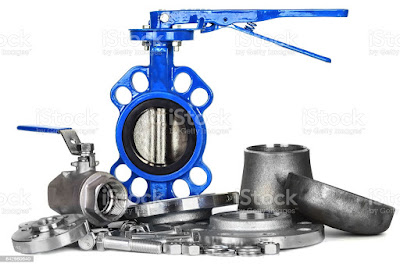Butterfly valve (API 609)
Butterfly valve is also called a quarter turn valve, this type of valve used for shutoff, regulating and starting the flow. The operation is either in open condition or fully closed of the disc in side body. In some applications it is also used as an alternative to a ball or gate valve. The installation space required is very little as compared to other types of valves.
Link here to learn more Basic application of gate valve
Butterfly valve The biggest advantage of butterfly valves is quick operations nowadays most of this type of valve is used equipped with a gearbox. Due to this arrangement, the valve operation is very simple. it has less force required to operate and another biggest advantage of butterfly valve is used for high pressure services and available in large size also.
A short circular body with circular types of disc metals used for seat disk, now days its operation is very like to the ball valves operation and it is available in large size applications also and also used with actuators the arrangement of this type of valve disk is fixed perpendicular to the flow. in which when the valve is in closed condition disc will be block the way of fluid flow. when the valve is in in open condition dish will be in the right angle of the flow of liquid.
Parts of butterfly valve
Standards and specifications
API 609, covers internal design, flange end to end (face) dimensions, pressure and temp rating, inspection, testing and tolerance of butterfly valve, followed by API 609 guidelines.
API 609 Divided into two categories of butterfly valve
Category 1 –
In this category used for cold working pressure services and with only concentric disk seat arrangement and normally in NPS 2 to NPS 48, with flange rating of class 150 and 125.
Category 2 –
Used for high temperature and pressure rating and mostly with offset disk arrangement (eccentric and concentric).
The flange selection on the biases of ASME (B16.1, B16.34, B16.5, B16.42 and B16.24) and others also.
The use of this type of valve is used in various types of temperature ranging from 20c to 180c. Depending on the material of construction has been used. The testing pressure is 1.5 times its design pressure.
Types of butterfly valve
On the basis of lug and flange type this is classified into four types
Lug and flange type
- Semi lug type
- Lug type
- Wafer type
- Double flange type
On the basis of inside disk offset arrangement, it is divided into three types.
Disk offset arrangement
- Center fixed (no offset) type
- Double offset type
- Triple offset
On the biases of valve operation type
Operation Type
- Manual Gearbox
- Electric actuator
- Manual operation
Butterfly valves are used in many applications like chemical, hydrocarbons, water line, waste water supply, fire system and power generation industries as well. The offset type of valve is mostly used in the oil, gas and petrochemical industries.
Working principle of butterfly valve
This is a quick operation type of valve, Disk is fixed in the center of the pipe bore (Valve body) or offset and that is supported by a shaft through it. An actuator is connected to the shaft with gearbox on the top of the body. The disk position in the valve during the open condition is parallel to the flow, and in close condition the disk position will be perpendicular to the flow of fluid. The open and close of the valve is done by just rotating the shaft with 90 degree (quarter turn) of the main shaft (stem). But nowadays an easy operation valve is assembled with a gear box mounted on top of the valve body, due to this very little force required to operate.
Valve operating torque and force
There are three type of torque work on butterfly valves
- Dynamic torque
- Static torque
- Seating torque
Application of butterfly valve
The type of valves used in many industries like Oil & Gas, Petrochemical Plants, Power Plants, Chemical Plants, ETP, WTP, Sugar Industries.
Advantages and disadvantages of butterfly valve
Advantages
There are many advantages and these are explained below.
- It is used for fully closed, fully open and throttling applications.
- For quick operation and a quarter turn, only rotate 90 degrees of stem.
- Fluid trap is very less during closing of the valve as compared to other types.
- Application where less pressure drop is required.
- Less space required for installation.
- Good flow control.
Disadvantages
There are many disadvantages and these are explained below.
- If gear is not used, high torque is required to operate.
- cavitation issue if used in low flow.
- Seat ring requires more maintenance due to its soft material.
to learn more details

